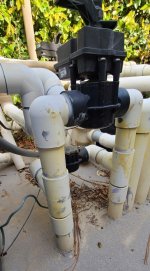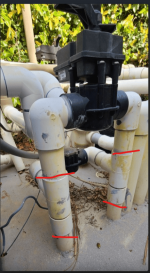- Jun 5, 2020
- 152
- Pool Size
- 18000
- Surface
- Plaster
- Chlorine
- Salt Water Generator
- SWG Type
- CircuPool RJ-60 Plus
I'm starting to plan my SWCG installation. I was originally going to hire a company to do it, but I haven't had any luck finding one interested. So, I feel like it would be better to just do it myself.
As part of the process I want to re-plumb the spa return, so that I can manually shut-off the spa spillover in pool mode, which can't be done as things are plumbed now.
I'll have a million questions over time as I plan this, but here are a few to start:
1. I've attached a photo of the existing installation. I'd like to remove the entire return pipe assembly and rebuild it from the heater outlet to the ground. As you can see in the photo, if I cut below the T-fittings that attach the spa check valve, there's only room on the return pipes for one more glued connection before getting to the ground. I'm thinking of gluing on a threaded connector, so that what I build could be disassembled later if something needs to be changed; but, I'm wondering about the durability of those connections. Any thoughts?
2. I've watched YouTube videos of people using heat to separate glued pieces of PVC. This is likely a crazy thing to attempt in this situation, but is there any hope of doing that to preserve the available length of pipe? Is there any way to separate glued pieces of PVC?
3. If a repair was needed on a pipe, and there was no piece available to glue on a union/coupling what solutions are there other than jack hammering the concrete out to expose more usable pipe length?
-Eric
As part of the process I want to re-plumb the spa return, so that I can manually shut-off the spa spillover in pool mode, which can't be done as things are plumbed now.
I'll have a million questions over time as I plan this, but here are a few to start:
1. I've attached a photo of the existing installation. I'd like to remove the entire return pipe assembly and rebuild it from the heater outlet to the ground. As you can see in the photo, if I cut below the T-fittings that attach the spa check valve, there's only room on the return pipes for one more glued connection before getting to the ground. I'm thinking of gluing on a threaded connector, so that what I build could be disassembled later if something needs to be changed; but, I'm wondering about the durability of those connections. Any thoughts?
2. I've watched YouTube videos of people using heat to separate glued pieces of PVC. This is likely a crazy thing to attempt in this situation, but is there any hope of doing that to preserve the available length of pipe? Is there any way to separate glued pieces of PVC?
3. If a repair was needed on a pipe, and there was no piece available to glue on a union/coupling what solutions are there other than jack hammering the concrete out to expose more usable pipe length?
-Eric



